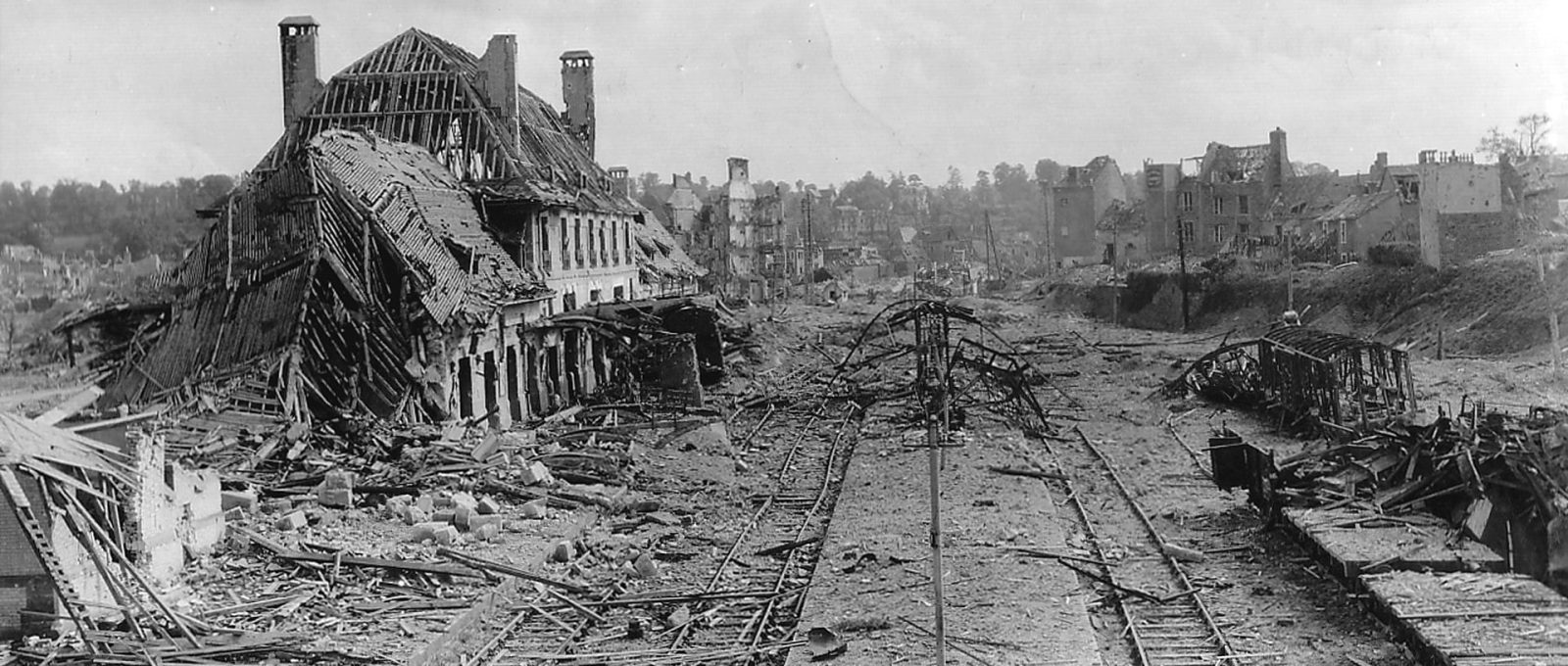While it takes decades, sometimes even centuries, of effort and resources to build and populate a thriving city, all of this can be destroyed in just a few days of war. Even today, densely populated settlements are deliberately and systematically targeted as a widely practiced strategy of warfare, often resulting in the near-total destruction of their cultural and historical heritage.
10. Saint-Lo, France

The Siege of Saint-Lô in France was one of the key battles of World War II, fought between the Allies and occupying German forces in the summer of 1944. It was part of the larger Battle of Normandy, as Saint-Lô was a key transport hub for the Allied landings on the Normandy coast.
Although the real battle began when American troops entered the city in July , he was subjected to massive bombing weeks before the assault, which resulted in the complete destruction of much of its infrastructure. Several bridges and railway lines were irreparably destroyed during the siege, and much of the civilian population was forced to flee the region.
Although it was a military success – as it was one of Germany's first major defeats on the Western Front – the bombing and destruction of Saint-Lô is still remembered as a controversial Allied decision. By the end of the war, Allied bombing had killed at least 8000 Normans and more than 60,000 French civilians in other occupied regions.
9. Grozny, Russia
The siege and subsequent battle for Grozny was one of the darkest episodes of the Second Chechen War. Beginning in 1999, Russian forces launched a full-scale assault on the Chechen capital, which had by then become a stronghold of the self-proclaimed Chechen Republic of Ichkeria. In the months leading up to the assault, the city was subjected to heavy bombardment as Russian forces imposed a blockade and subjected militants and civilians to relentless aerial bombardment.
Although they encountered fierce resistance when they finally entered the city in February 2000, the city was eventually captured and most of the fighters were forced to flee. Grozny itself was left in ruins to the point that the UN declared it "the mostdestroyed city on Earth." In addition to the complete destruction of vital infrastructure, many civilian areas were also devastated and will take years before they can be fully rebuilt. According to some human rights groups, during the two-month campaign, people died to 25 000 civilians.
8. Rovaniemi, Finland

When World War II began, Finland found itself in a precarious position as it fought its own war against the Soviet Union, now known as the Winter War. In November 1941, it signed Anti-Comintern Pact with the other Axis powers, effectively handing over the northernmost part of the country to the Nazi forces. This meant that German bases quickly sprang up in Lapland, particularly in and around the capital, Rovaniemi. As the war progressed, the Germans increasingly entrenched themselves in the city, building fortifications, airfields, and other defensive structures.
Of course, the situation changed dramatically in 1944, when advancing Soviet troops demanded that the country expel the Germans or risk another war with the USSR. Finland complied and gave the order to expel all Axis units by October 1944. However, as they retreated, the German troops decided to devastate the entire city and its infrastructure, destroying more than 90% his over the next few weeks. This included the destruction of key facilities and all military installations in the city, as well as most of the city's residential areas.
7. Palmyra, Syria

Palmyra, also called " Venice of the sands ", is an ancient city in what is now Syria that once served as an important trading center between the Mediterranean and the East. Its unique blend of Roman, Greek and Persian influences made it an important historical and cultural site in the region, as the city contained many well-preserved artifacts, temples, tombs and ancient sculptures.
Unfortunately, much of this legacy came to a tragic end in 2015 when ISIS militants captured Palmyra and began a campaign of total destruction. They systematically attacked and destroyed much of the city's historic heritage, including the Temple of Bel and the Roman Triumphal Arch. They also executed a number of Palmyra's residents, including the brutal beheading of the city's chief archaeologist Khaled al-Asaad , who dedicated his life to studying and preserving this place.
6. Magdeburg, Germany

The Thirty Years' War was one of the longest and destructive conflicts on European soil that lasted from 1618 to 1648 year . It was fought primarily by the Holy Roman Empire, the Dutch Republic, Spain, Denmark, Sweden and Germany, although the whole of Europe was involved in the conflict in one way or another. It was caused by a combination of political, social and economic factors, especially the growing divide between Catholics and Protestants at the time.
One of the most infamous events was the sack of Magdeburg, a Protestant city in what is now Germany, after a long siege that ended on 20 May 1631 It was a chaotic massacre as the Catholic coalition forces burned the city and killed more than 20,000 people. The infrastructure was almost completely destroyed, with about 1700 Of the city's 1,900 buildings, they were burned or destroyed. The destruction was so extensive that by 1639, only 450 inhabitants, compared to a total population of over 25,000. It took another two centuries before Magdeburg was able to recover and grow again.
5. Pyongyang, North Korea

The bombing of Pyongyang, Korea, began in June 1950, as it became increasingly clear that North Korean forces were about to advance on the city. As a preemptive measure, U.N. forces led by U.S. and South Korean contingents dropped a total of 420 000 bombs on a city of about 400,000 people, including about 32,000 tons of napalm.
The damage was so extensive that by the end of the war, only a few buildings remained standing. About 75% of Pyongyang was destroyed in the bombing, including factories, hospitals, schools, government buildings, residential areas, and even hydroelectric power plants and irrigation dams in the later stages of the war. According to one journalist, within days the city ran out of military targets to attack as coalition forces bombed « "each brick standing on top of the other."
4. Ypres, Belgium

Belgium was the site of extensive fighting throughout World War I, with German forces invading and occupying the country in the early years of the conflict. The city of Ypres, in western Belgium, saw some of the fiercest fighting on the front, as it was a key strategic location throughout the war. The first major battle for control of Ypres took place in the autumn of 1914, and the city was subsequently repeatedly attacked and heavily shelled.
By the end of it all, Ypres was almost completely destroyed , and some of its most iconic structures were left in ruins. These included Cloth Hall — the centre of the city's economic life since the 13th century — and the historic St. Martin's Cathedral, as well as many other churches and cultural sites. Although it is now a popular tourist and cultural destination in Belgium, it will take many years before Ypres can be fully restored to its original architectural style after the war.
3. Baghdad, Iraq

Baghdad was an important cultural, intellectual and economic centre of the Islamic Golden Age, which began with the founding of the Abbasid caliphate in the eighth century. It was a major center of trade, learning, and religious scholarship, and home to the largest libraries in the world at that time - the House of Wisdom.
Although the city flourished for a time, unfortunately it was captured by the Mongols in 1258, which had a significant impact on the region and beyond. The sack of Baghdad resulted in massive destruction and death as the city was systematically looted and destroyed by the Mongol forces over several days. The entire population was either killed or sold into slavery - according to Mongolian estimates, died during the assault more 200 000 Human. Most of the city's buildings were also burned to the ground, including the House of Wisdom and the Great Mosque.
2. Manila, Philippines

The Battle of Manila, which lasted from February 3 to March 3, 1945, was fought between a coalition of American and rebel Filipino forces against the occupying Japanese army. While the entire occupation was brutal for the city's residents, it was nothing compared to the scale of destruction seen during the month-long battle.
In the lead-up to the battle, the city was heavily bombed by American aircraft, and urban fighting between Japanese and American troops left much of it in ruins. As Japanese troops retreated, they began a campaign of terror against civilians, raping, torturing, and killing suspected guerrillas throughout the city. It was one of the greatest tragedies of the entire war, as almost the entire city was erased from the face of the earth by air or artillery bombings In total, about 100,000 Filipinos, most of them civilians, died during the Battle of Manila, making it the second most devastated place of the war after our next entry.
1. Warsaw, Poland

Warsaw was the first capital to be occupied on the European front during World War II. It was a major target for the Nazis because of its large Jewish population. population , as the city was home to many prominent Jewish political, cultural and religious organizations. It was also one of the most rebellious cities occupied by the Germans, as the entire occupation was marked by minor and major uprisings of armed Polish insurgents, such as the Warsaw Ghetto Uprising V April 1943.
When another of these uprisings failed in the summer of 1944, Adolf Hitler ordered his troops to completely destroy the city. According to Heinrich Himmler's specific instructions, "the city must completely disappear from the surface of the Earth," which was carried out with alarming efficiency over the next few weeks.
When the Red Army entered Warsaw in January 1945, they found that every part of the once thriving metropolis had been burned or destroyed by explosives. It was a wasteland, with most of the population either dead or deported to one of the concentration camps. Warsaw is still remembered as the most completely destroyed city of the war, and perhaps of all history, because about 85% it was completely wiped off the face of the earth.














Оставить Комментарий